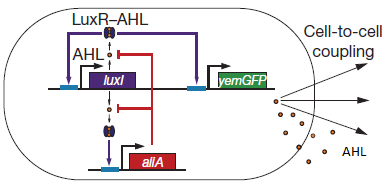Team:Wageningen UR/Project/ModelingProj1
From 2011.igem.org
(→Modeling synchronized oscillations) |
(→Modeling synchronized oscillations) |
||
| Line 42: | Line 42: | ||
=== Mathematical model of the construct === | === Mathematical model of the construct === | ||
| - | Since our bio bricked oscillatory system is based on the design seen above, our first model of the system is a reproduction of the mathematical model in the supplementary information accompanying the publication mentioned. In their simulations, Danino et al. used the following set of delay differential equations, which we used | + | Since our bio bricked oscillatory system is based on the design seen above, our first model of the system is a reproduction of the mathematical model in the supplementary information accompanying the publication mentioned. In their simulations, Danino et al. used the following set of delay differential equations, which we used for our simulation tool written in matlab. }} |
[[File:Equations_hasty_WUR.png|350px|center]] | [[File:Equations_hasty_WUR.png|350px|center]] | ||
| Line 63: | Line 63: | ||
{{:Team:Wageningen_UR/Templates/Style | text= __NOTOC__ | {{:Team:Wageningen_UR/Templates/Style | text= __NOTOC__ | ||
| - | The production of AiiA and LuxI depend on the internal AHL concentration in the single cell. The steps from gene to protein (transcription, translation, maturation etc.) are not modeled separately, but | + | The production of AiiA and LuxI depend on the internal AHL concentration in the single cell. The steps from gene to protein (transcription, translation, maturation etc.) are not modeled separately, but the delay is simulated by the following Hill function: }} |
[[File:Equations2_hasty_WUR.png|150px]] | [[File:Equations2_hasty_WUR.png|150px]] | ||
| Line 69: | Line 69: | ||
{{:Team:Wageningen_UR/Templates/Style | text= __NOTOC__ | {{:Team:Wageningen_UR/Templates/Style | text= __NOTOC__ | ||
| - | in which tau represents the time step between the relevant internal AHL concentration and the corresponding AiiA and LuxI | + | in which tau represents the time step between the relevant internal AHL concentration and the corresponding AiiA and LuxI. |
[[File:Equations3_hasty_WUR.png]] | [[File:Equations3_hasty_WUR.png]] | ||
}} | }} | ||
Revision as of 22:03, 11 September 2011
 "
"





